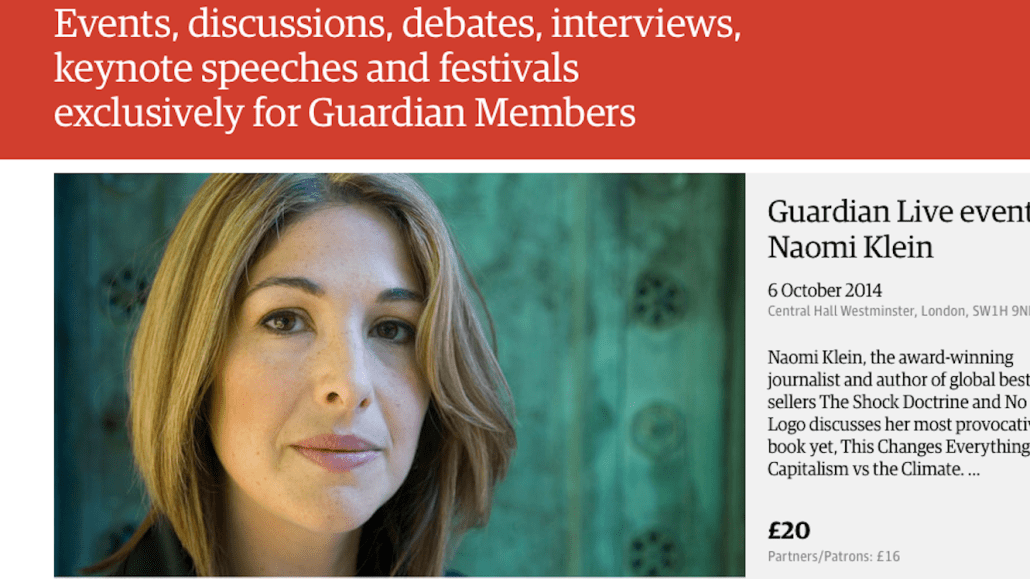
It was the best of membership programs; it was the worst of membership programs.
With ad revenue softening, publishers are looking to subscriptions and their close cousin, membership programs, among other sidelines. While they can be revenue drivers, they also serve the dual purpose of helping build a more engaged audience (which, it’s hoped, ultimately will translate into a more stable audience and more advertising appeal). Depending on the publisher’s goals, a membership program can be as inclusive — or exclusive — as they want. Here, then, are two publishers that are taking opposing approaches.
The elitist approach
The Wall Street Journal is singular among major U.S. dailies in that it has had an online paywall from the start. Today, with 2.3 million paying subscribers, the Journal is the model for how a paywall can be successful (at least when applied to specialty news and information that’s not easily found elsewhere).
So with ad revenue down in the News Corp business unit that includes the Journal, it’s no wonder the Journal is trying to protect its circulation base by keeping its paying customers happy. Hence WSJ+, a new membership program “exclusively for subscribers.”
Given subscribers already pay a fair amount to get the Journal ($28.99 month for print and digital, $24.99 for digital-only), WSJ+ is free to subscribers. The program has a range of experiences and offers behind the velvet rope, like access to Journal-hosted talks, private museum tours and discounts on golf fees and other luxuries. The program was touted as part of a larger effort to deepen its reader engagement and grow its subscriber numbers. By focusing on lifestyle topics, it underscores the Journal’s coverage of those subject areas.
In a day when companies are wooing new customers with perks, the program is a way to reward the Journal’s current readers, said Katie Vanneck-Smith, Dow Jones’ new chief customer officer and global managing director.
“It’s a thank-you for being a loyal customer,” she said. “It’s another reason to subscribe as part of the overall proposition. You subscribe to the Journal, but the relationship you have, the passions you follow, there’s a lot more experiences you have with that that can enhance that subscription proposition.”
Newsstand buyers need not dismay, though. While the program is advertised as being for subscribers only, Vanneck-Smith said non-subscribers who ask can get in on the perks for a $189 “joining fee.”
The populist approach
If you’re not among the select few who qualify for the Journal’s membership program, consider the Guardian’s. Its new program, announced today, is a series of live events that are open to all. So far, the events scheduled are in the U.K., but a number are expected to be added in the U.S. The goal is to bring the Guardian’s journalism to life and serve its bigger mission of becoming known as a global news brand.
While the Journal’s membership program is designed to protect its existing revenue, the Guardian, which has foregone a paywall for audience growth, needs its membership program to generate new revenue to support the spread of its journalism.
“Putting a wall around our content is just incredibly contradictory to who we are,” said David Pemsel, the Guardian’s deputy chief executive. “We do not believe in putting something between us and our readers. We also think it would curtail our global ambitions.”
The program has three membership tiers. “Friends” join for free and can pay to attend events. “Partners” pay 15 pounds a month and get discounts to events and priority booking. For 60 pounds a month, “Patrons” get that plus access to Guardian newsroom events.
In addition to generating revenue, there’s a side benefit to the program in that Guardian plans to use personal data (name, address and email) that members provide at sign-in to personalize editorial content and ads to them.
“There’s clearly an opportunity to be able to get to know our readers better,” said Pemsel. “Through membership, you’ll be able to read something in the paper, get a more multimedia expression on mobile, and also through events, get a live experience.”
More in Media

Meta AI rolls out several enhancements across apps and websites with its newest Llama 3
Meta AI, which first debuted in September, also got a number of updates including ways to search for real-time information through integrations with Google and Bing.

Walmart rolls out a self-serve, supplier-driven insights connector
The retail giant paired its insights unit Luminate with Walmart Connect to help suppliers optimize for customer consumption, just in time for the holidays, explained the company’s CRO Seth Dallaire.

Research Briefing: BuzzFeed pivots business to AI media and tech as publishers increase use of AI
In this week’s Digiday+ Research Briefing, we examine BuzzFeed’s plans to pivot the business to an AI-driven tech and media company, how marketers’ use of X and ad spending has dropped dramatically, and how agency executives are fed up with Meta’s ad platform bugs and overcharges, as seen in recent data from Digiday+ Research.





